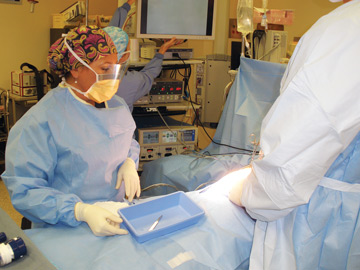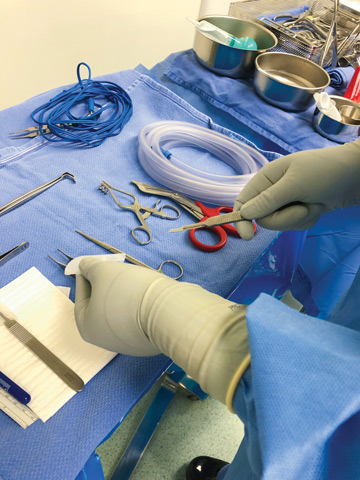- Don't re-use syringes for lidocaine injections. Some doctors want to reload lidocaine into the syringe, because it's quick and efficient and the vial poses no infection threat because it gets thrown away after that procedure.
But the syringe has already been in the patient, so it poses a risk to the staff. Explain to your surgeons why it's important to not re-load. And educate your nurses on ways to keep efficiency high after the change. Tell them to have several
syringes pre-loaded, or on hand ready to load. Make sure they activate the safety feature when the surgeon is done with it. Reinforce all of this in huddles and time outs.
- Eliminate hand-to-hand sharps transfers. Create a neutral zone for hands-free passing of instruments whenever possible. Whether it's a brightly colored tray or a towel, have some sort of barrier for the transfer from the surgeon
to the scrub nurse, tech or whomever is accepting the sharp. Make sure all parties are communicating about the transfer, and that the recipient of the sharp can pick it up in a safe manner without having to move it to avoid its sharp end.
We've instructed our nurses to hold the tray out even if a doctor tries to insist on manually passing a sharp to them.
- Designate a place for sharps post-use. Have a tray in which to place sharps after use. Make sure the container is big enough so that nothing is protruding from it as you make your way to the disposal box or the reprocessing
cart.
- Explain how to activate the safety features. Data from the American Nurses Association (ANA) shows that nearly two-thirds of nurses have had a sharps injury at some point in their career. The ANA also says safety syringes
can reduce needlestick injuries to medical personnel by 80%, and that figure can climb to 90% with worker education efforts. But people need to know how to activate and deactivate the safety features — and actually use them —
for these reductions to occur. A recent report by the International Safety Center on 2018 data from the Exposure Prevention Information Network (EPINet) shows that 44% of sharps injuries took place in surgical settings where safety sharps
were often used but the safety features had not been activated.
- Make sharps safety education a part of employee orientation. Even though the sessions include non-medical staff, the 2018 EPINet data shows that 25% of those injured by sharps weren't the people who first used them. That means
employees downstream from the procedure, such as central processing or housekeeping employees, got stuck. So they could benefit from learning about what a safety sharp looks like and what disposal units look like, where they're located
and for what they're used.
Teach sharps users how to use syringes that require single-handed activation as well as those that retract automatically. They also need to know how to properly use disposal units. I bring safety sharps and a disposal box to the orientation sessions
and show them how they're used.
3. Relationship-based care. Our hospital used to send the employee who had a sharps injury an email that noted we were aware of the incident, and attached an informational brochure from the Centers for Disease Control
and Prevention. To say the least, I found that to be an impersonal way to address the situation.
We've instructed our nurses to hold the tray out even if a doctor tries to insist on manually passing a sharp to them.
Now, I go see them in person. If it's a younger employee, they might be disappointed in themselves or fearful that their bosses will think they've done something wrong. Sometimes the informal feedback from older colleagues isn't good if they minimize
the sticks and chalk it up to an inevitable rite of passage. When we talk, I try to change their feeling that a stick is just part of the job. I explain that HIV and hepatitis B and C are alive and well. I make sure the talk isn't a lecture,
but a teaching moment in which I explain sharps injuries are preventable if they keep their focus in that moment, and not think about the 30 other things on their to-do list.
Also, I don't go in with a "I can't believe you had a needlestick" attitude. We accept that it happened, I ask if they're OK and if they have any concerns, and if there's anything they need from me to help to prevent it from happening
again.
4. Crucial conversations. When you have these conversations with compassion, it opens up a lot of things. I'm then able to walk through the process with them. I can calm them down, explain that while a sharps injury
is reportable to OSHA and that our accreditation hinges in part on how many incidents we have, it's OK. If they're concerned about a potential infection, I explain how the size of the bore of the needle, the amount of blood on the syringe
and the length of the time the needle was in the skin are all factors in infection transmissions. It was during these conversations that I realized a lot of younger nurses were never taught how to activate the safety features on sharps in
nursing school.
.svg?sfvrsn=be606e78_3)


.svg?sfvrsn=56b2f850_5)